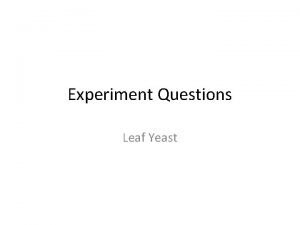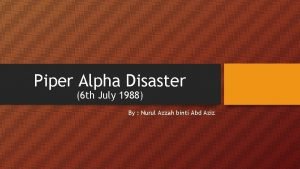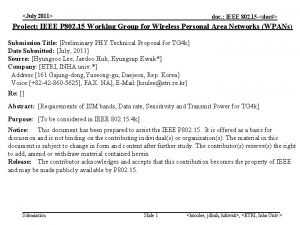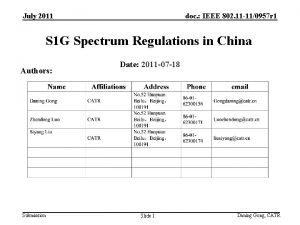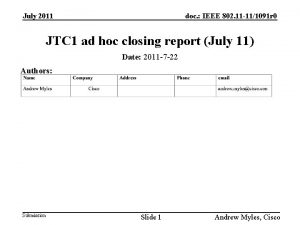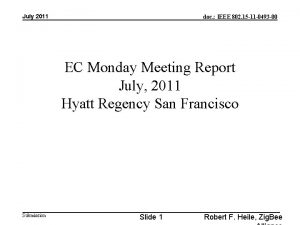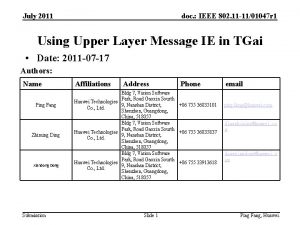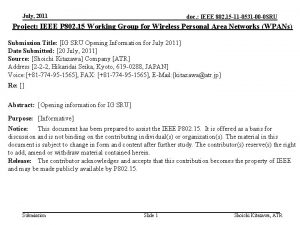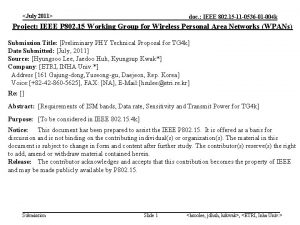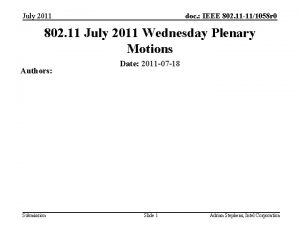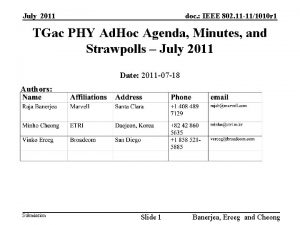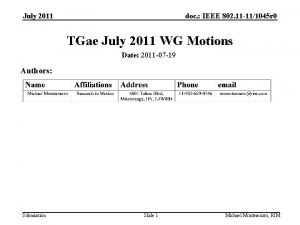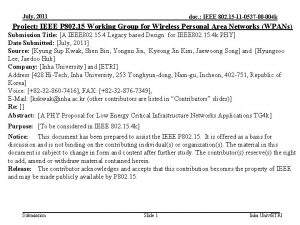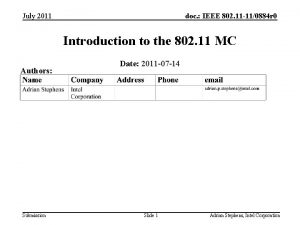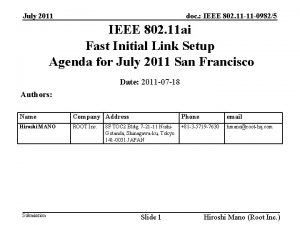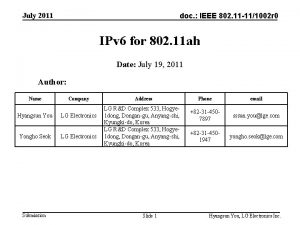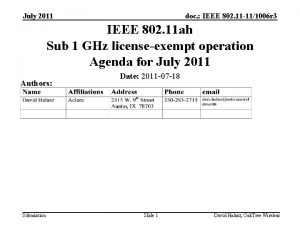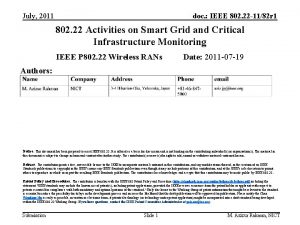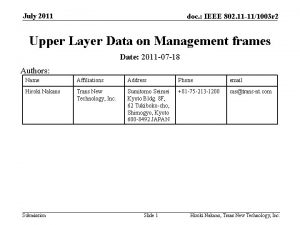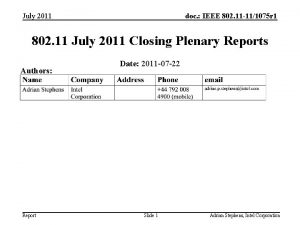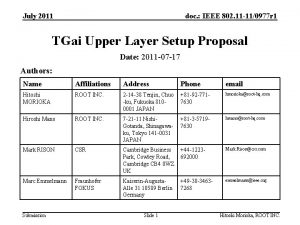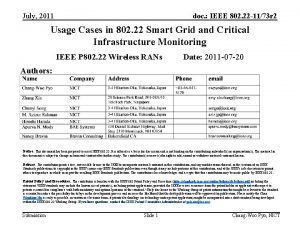July 2011 doc IEEE 802 11 111036 r

























- Slides: 25

July 2011 doc. : IEEE 802. 11 -11/1036 r 0 Improving the Case for Wireless LAN Transmit Power Control— including to better service Mobile Telephones? Date: 2011 -07 -19 Authors: Submission 1 Lawrence H. Zuckerman, National Semiconductor Corp.

July 2011 doc. : IEEE 802. 11 -11/1036 r 0 Abstract Test results are presented that show significant reduction of mobile phone battery current when Wi. Fi transmit power output is reduced. A 1994 802. 11 submission on elaborate clear channel assessment is resurrected, wherein it is suggested that with considerable added network intelligence that includes definitive RF output control would increase throughput. Submission 2 Lawrence H. Zuckerman, National Semiconductor Corp.

July 2011 doc. : IEEE 802. 11 -11/1036 r 0 Introduction • There has been considerable discussion during the past five or so years as to whether or not a definitive transmit power control algorithm should be part of the 802. 11 standards in general, not just in the cases where they are mandated by regulations. • Given the evolution of wireless LANs to Access Points, as opposed to Ad-hoc groups, such power control may resemble that found in the cellular networks, where it was first mandated by the technical requirements of DSSS implementation (“CDMA”, etc. ) • Thus far, proponents of definitive TPC failed to show sufficient benefit to network throughput or for the users in other ways. Submission 3 Lawrence H. Zuckerman, National Semiconductor Corp.

July 2011 doc. : IEEE 802. 11 -11/1036 r 0 Large File Uploading from Phones— How much? • File down-loading normally primary use of phone. Requires only minor use of PA—power control not warranted. Major uses: Reading articles & promotional materials; watching videos • Large file up-loading varies with user. Primary uses are self-produced or relayed picture sets or videos. Possibly revised social networking pages or work products such as slide presentations. Present or future uses may include video games. • Need statistics on how much large file uploading is used. • Need statistics on sizes of large files being uploaded. – Could use JPEG & MPEG file sizes – Nothing known about present or future on-line/interactive video games Submission 4 Lawrence H. Zuckerman, National Semiconductor Corp.

July 2011 doc. : IEEE 802. 11 -11/1036 r 0 Availability of Wi. Fi Access Points • What is probability that user is at Access Point when he has data to upload? – Studies have indicated that on the average, users are in some hot spot 70% of their waking hours, that they spend 2 hours in each hot spot & return to some hot spot in 40 minutes. • Building more hotspots is much less costly than increasing 4 G capacity. • How long can/will user wait to be at an Access Point? Often, data does not need to be sent immediately. • What incentives can be presented to the user to wait for proximity to Access Point? – Costly 3/4 G time vs. free or much lower cost AP time (already the case when traveling in foreign country). – Users know/will know that uploads are much quicker at APs Some information from this slide from Lee, Rhee, Lee, Chong, Yi—“Mobile Data Offloading: How Much Can Wi. Fi Deliver? ” Submission 5 Lawrence H. Zuckerman, National Semiconductor Corp.

July 2011 doc. : IEEE 802. 11 -11/1036 r 0 Basic Reasons Why Wi. Fi Use Results in Reduced Battery drain • Wi. Fi data rate is much higher than 3/4 G— 54 Mb/Sec vs 22 Mb/sec upstream; so transmitter is running for a shorter period of time to send the same information. • Wi. Fi Access Point (AP) is tens to hundreds of feet away from phone instead of thousands of feet away to miles for a cell site; so lower transmit power is needed for similar data rate. • Path loss of 85 d. B 64 feet from APs supports use of 802. 11 g service by phones. • Path loss to cellular antenna sites are normally well over 100 d. B. Submission 6 Lawrence H. Zuckerman, National Semiconductor Corp.

July 2011 doc. : IEEE 802. 11 -11/1036 r 0 Opportunities to Reduce Power When Wi. Fi is in Use • To reduce interference to adjacent access points, the access points could reduce transmit output power and order the users (“stations”) to do the same when it can be done without data loss. • Based upon measured signal strength of access points (APs) & knowledge of the access point’s effective radiated power (data field provided by 802. 11 v), the phone can unilaterally reduce its transmit output power without suffering data loss. • -67 d. Bm needed for 802. 11 g, exists at typical AP 64 ft from (phone) with ERP of +18 d. Bm. • Assume PA output is +22 d. Bm and antenna gain is -4 d. B, to radiate +18 d. Bm. • 20 ft from AP, only about +10 d. Bm will be needed from amplifier Submission 7 Lawrence H. Zuckerman, National Semiconductor Corp.

July 2011 doc. : IEEE 802. 11 -11/1036 r 0 Assistance Requested from Mobile Phone Makers • The following statistics are needed: – Quantify present and future time usage of large files being uploaded from phones. – Quantify the sizes of these large files. Submission 8 Lawrence H. Zuckerman, National Semiconductor Corp.

July 2011 doc. : IEEE 802. 11 -11/1036 r 0 DC-DC Converter-Augmented RF Power Amplifier in Mobile Phone 4. 3 V fully charged 3. 8 V main life Voltage conversion Non Dissipative Battery DC-DC Converter RF in Submission 9 Final Amplifier RF out Lawrence H. Zuckerman, National Semiconductor Corp.

July 2011 doc. : IEEE 802. 11 -11/1036 r 0 3. 8 V Battery Current Reduction w/DC-DC Converter on RF PA, 802. 11 g, 54 Mb/S OFDM Submission 10 Lawrence H. Zuckerman, National Semiconductor Corp.

July 2011 doc. : IEEE 802. 11 -11/1036 r 0 3. 8 V Battery Current Reduction w/DC-DC Converter on RF PA, 802. 11 g, 54 Mb/S OFDM Submission 11 Lawrence H. Zuckerman, National Semiconductor Corp.

July 2011 doc. : IEEE 802. 11 -11/1036 r 0 Reduction of Battery Current w/Distance from Access Point & Needed RF Output Power • Even at power output of +22 d. Bm, needed for 802. 11 g at 64 feet from Access Point, application of DC-DC converter reduces Ibatt by 120 m. A, 444 m. W (44%) • For reduction of power output to +10 d. Bm, allowable if 20 feet from Access Point, PA itself can reduce Ibatt from 151. 2 m. A to 40. 7 m. A by going into medium power mode • Using DC-DC Converter, there is an additional reduction of 22. 8 m. A, 84. 4 m. W (44%). • A Wi. Fi PA device not configured to use a DC-DC converter draws 225 m. A while delivering +22 d. Bm (the maximum it can deliver while meeting all 802. 11 standards) and 95 m. A while delivering +10 d. Bm Submission 12 Lawrence H. Zuckerman, National Semiconductor Corp.

July 2011 doc. : IEEE 802. 11 -11/1036 r 0 Reduction of Battery Current w/Distance from Access Point & Needed RF Output Power 64 20 Submission 13 feet Lawrence H. Zuckerman, National Semiconductor Corp.

July 2011 doc. : IEEE 802. 11 -11/1036 r 0 Former address redacted Submission 14 Lawrence H. Zuckerman, National Semiconductor Corp.

July 2011 doc. : IEEE 802. 11 -11/1036 r 0 Summary of Advanced CCA Method in 94/132 Further Topics in Submission • • • Submission Careful set of definitions of terms used Comments on existing CCA recommendations The proposed elaborate CCA Method Estimation of network efficiency improvement Implementation details and issues 15 Lawrence H. Zuckerman, National Semiconductor Corp.

July 2011 doc. : IEEE 802. 11 -11/1036 r 0 Fundamental Problem of Clear Channel Assessment as it is now done The fundamental problem of present CCA is that the Subject Node can be cognizant of the interference conditions only at his location, yet an accurate CCA can be performed only if one knows the conditions at his Recipient’s location, the Incumbant’s location, and the location of Incumbant’s Recipient. New Term Coined: TDA instead of CCA It is useful to define a new term. In radio work on uncontrolled bands there is, in general, no clear channel; so Clear-Channel Assessment is really a misnomer. The new process uses a complicated formula to determine whether or not to defer. Therefore, the new name for this process is TRANSMISSION DEFERRAL ASSESSMENT or “TDA”. Submission 16 Lawrence H. Zuckerman, National Semiconductor Corp.

July 2011 doc. : IEEE 802. 11 -11/1036 r 0 Basic TDA Idea (1) First, it is necessary to display Effective Radiated Power (“ERP”) in every Fragment preamble, with a resolution of 1 d. B. If the overall range is from 1 m. W up to 1. 6 W, only 5 bits are required. Variable transmit ERP on a per-packet basis would provide additional throughput improvement. 3 d. B steps would be ideal, but any ERP variation would be helpful. By keeping (initiating and updating) a (“Chart”) of transmitted and received ERP for every readable Node, each Node would have rough distance data (i. e. could draw concentric circles representing the distances). More precisely and importantly, each Node would “know” the path loss between himself and every other Node. Submission 17 Lawrence H. Zuckerman, National Semiconductor Corp.

July 2011 doc. : IEEE 802. 11 -11/1036 r 0 Basic TDA Idea (2) Secondly, in some prescribed manner, each Node periodically transmits Chart; so that every Node ends up with all the Charts. The system determining when a Node includes his Chart (or even on occasion another Node’s Chart, to eliminate the Hidden Node effect) as a field, is governed by many factors, such as network loading and perceived changes to his Chart. During periods of light loading, the Charts can be broadcast via special network maintenance Transmissions; so they are ready for efficient operation when payload Packets/Fragments are ready. Submission 18 Lawrence H. Zuckerman, National Semiconductor Corp.

July 2011 doc. : IEEE 802. 11 -11/1036 r 0 Basic TDA Idea (3) • • The Subject Node does not need to draw a map; it has the exact information it needs to perform TDA: Incumbent Node’s ID, ERP, and Recipient’s ID, from Incumbent Node’s preamble; Path loss between the Incumbent Node and Recipient; Path loss between himself and his own Recipient; Path loss between himself and the Incumbent Node’s Recipient; Path loss between the Incumbent Node and Subject’s Recipient. All Subject has to do to begin a Transmission is calculate the lowest ERP which makes him 15 d. B or more stronger than the Incumbent Node at his own Recipient’s location (and strong enough to be decoded by Same) and 15 d. B or more weaker than the Occupying Node at the latter’s Recipient. If no such ERP is available to Subject, he Defers! The method works equally well for 3 -dimensional geometry. Submission 19 Lawrence H. Zuckerman, National Semiconductor Corp.

July 2011 doc. : IEEE 802. 11 -11/1036 r 0 The method will increase network throughput, because it will decrease the probabilities of both False Deferrals and Ruined Transmissions. Owing to the available information, there is a greater probability of finding a high enough ERP; as every Transmission, including the ones initiated with no Activity, can be made using minimal ERP. Submission 20 Lawrence H. Zuckerman, National Semiconductor Corp.

July 2011 Submission doc. : IEEE 802. 11 -11/1036 r 0 21 Lawrence H. Zuckerman, National Semiconductor Corp.

July 2011 Submission doc. : IEEE 802. 11 -11/1036 r 0 22 Lawrence H. Zuckerman, National Semiconductor Corp.

July 2011 doc. : IEEE 802. 11 -11/1036 r 0 Fortunate Results of this CCA (“TDA”) Method • Hidden transmitter effects are mitigated • For many occasions, a transmission can be made without interference, even while another transmission is in progress. • Method works best with Transmit Power Control Submission 23 Lawrence H. Zuckerman, National Semiconductor Corp.

July 2011 doc. : IEEE 802. 11 -11/1036 r 0 Further Work Needed/Requested • Study and critique Submission P 802. 11 -94/132 & 132 R 1 • Update the calculations to account for present-day modulation and symbol rates. • Complete and update the “Estimation of Network Efficiency Improvement” that starts on Page 8 and goes to Page 15. • Invent additional/complementary ways to use intelligent computing power to make the access points and stations work together to regulate transmitter output power and increase network throughput. Submission 24 Lawrence H. Zuckerman, National Semiconductor Corp.

July 2011 doc. : IEEE 802. 11 -11/1036 r 0 References • Zuckerman; IEEE 802. 11 -94/132 & /132 r 1 • Backes, Kwak, Durand, Qi, Ashley 802. 11 -07/0695 Submission 25 Lawrence H. Zuckerman, National Semiconductor Corp.
 Bridges from 802.x to 802.y
Bridges from 802.x to 802.y Bridges from 802.x to 802.y
Bridges from 802.x to 802.y Ieee 802
Ieee 802 Ieee 802 family
Ieee 802 family Ieee 802 3 compliance
Ieee 802 3 compliance Wlan standards
Wlan standards Arquitetura ieee 802
Arquitetura ieee 802 Modelo ieee 802
Modelo ieee 802 Ieee 802 standard
Ieee 802 standard Ieee 802 bluetooth
Ieee 802 bluetooth 802 ieee
802 ieee Astronomy picture of the day 11 july 2001
Astronomy picture of the day 11 july 2001 Tender mean
Tender mean Super saturday tribal bingo july 4
Super saturday tribal bingo july 4 July 1969
July 1969 Sources nso frenchhowell neill mit technology...
Sources nso frenchhowell neill mit technology... Growth of leaf yeast experiment
Growth of leaf yeast experiment Harris burdick missing in venice
Harris burdick missing in venice June 22 to july 22
June 22 to july 22 Imagery in poppies in july
Imagery in poppies in july 2001 july 15
2001 july 15 January february march april may june july
January february march april may june july 6th july 1988
6th july 1988 July 4 sermon
July 4 sermon What is the significance of july 4 1776 brainpop
What is the significance of july 4 1776 brainpop July 26 1953
July 26 1953
















